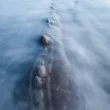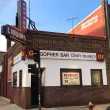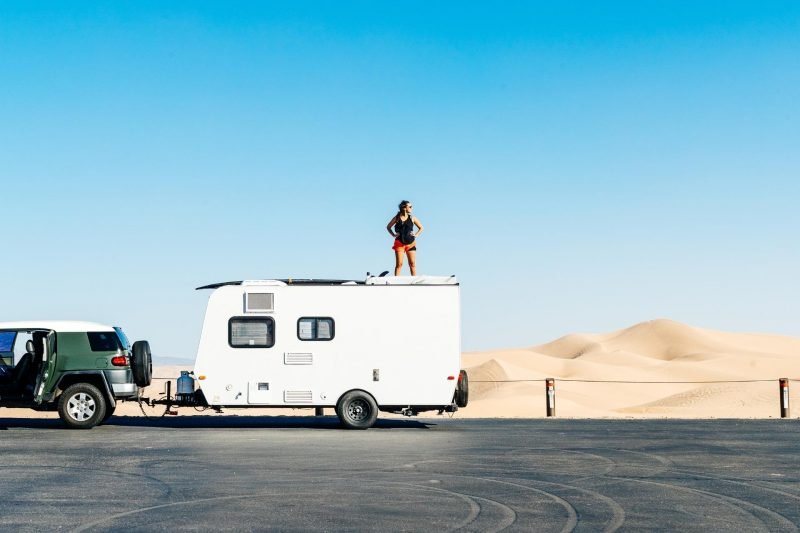You’ve probably seen the pictures on Instagram or videos on TikTok — the gorgeous oranges and reds of the sunset glowing over deep canyons. No one and nothing is in sight except for one lone RV parked on the side of a cliff. You think this must be the most perfect place in the world to get away from the stresses of life.
Boondocking certainly has its perks, and it lures travelers with its off-grid environment. But properly camping in these situations is critical to protecting the land you’re there to enjoy.
Let’s look at why it’s so important to dump your tanks correctly when boondocking.

What Is Boondocking?
Boondocking, sometimes referred to as dry camping, is when your RV is not hooked up to electricity, water, or sewage. You might be parked in a Walmart parking lot or on Bureau of Land Management (BLM) land.
Some people enjoy this type of camping more because it’s more remote, more connected with nature, and away from other RVers. RVs must be self-sufficient and able to provide water, and electricity and contain waste.

How Do You Dump the Black Water Tank When Boondocking?
RVs must have tanks to hold waste when boondocking. The toilet will still flush if water is in the fresh tank. You can still take a shower with water in the fresh tank.
But that water has to have somewhere to go, and that can not be on the ground. When boondocking, you must figure out how and where to dump that waste once your tanks are full.
Dump stations are in many different places. These stations provide a hole in the ground that connects to the sewer lines. They are safe places to empty your tanks when boondocking. However, you must have your own hoses in order to dump.
It’s just like hooking up at a campground that provides hook-ups. You’ll connect your sewer hose to the tank valve and connect the other end of the hose to the hole in the ground. When you release the valve on the grey tank, the waste from your sinks and shower goes into the sewer.
Releasing the valve on the black tank makes the waste from your toilet go into the sewer. Always release the black tank first so the gray tank water can clean the hose and any leftover waste.
Campgrounds
If you’re near a campground, you can call and see if that location has a dump station. If so, the campground might charge you a small fee, but you can drive to the campground and dump your tanks at the dump station. You can then return to your boondocking site or continue on your way to another location.
Campgrounds might also let you pull into an empty site to dump if there is no dump station on the property. Many full hook-up campgrounds won’t have a separate dump station because each site has its own.

Gas Stations or Truck Stops
You can also use different apps to help you locate dump stations at gas stations and truck stops. It’s always important to do a satellite view of the location so you can see whether or not your rig will fit and how easy it will be to get in and out.
But just like a dump station at a campground, gas stations and truck stops will often have a place off to the side where RVers can empty their tanks.
You can also access air, fuel, restrooms, and food at these locations. This makes stopping at a gas station or truck stop more convenient than a campground. Most of the time, the service is free.
Rest Areas
Rest areas are another place you can find dump stations. Again, by using a dump station locator app, you might find a rest area nearby that provides this service. Like gas stations and truck stops, these locations also provide access to restrooms, food, and picnic tables.
You won’t be able to fill up with fuel, but you can usually feel confident about entering and exiting a rest area with no problems. That’s because there’s often designated RV parking.

RV Dealerships
Many dealerships have dump stations because they have to make sure everything works when rigs arrive from the manufacturers. They’ll plug in the electricity, run the water, and empty the tanks to ensure all the systems are working correctly.
If you call a nearby dealership, you can ask permission to use their dump station. There may be a fee like using a dump station at a campground. But, this is another location where you can feel confident getting in and out safely.
Approved Municipal Sewer Systems
Finally, you can use an approved municipal sewer system to dump your tanks once you get home. Outside many residences is a city sewer connection with clean-out.
It’s a 4-inch PVC pipe that looks very similar to a campground sewer connection. You might need a big wrench or pliers to unscrew the cap.
However, remember when dumping your tanks that your septic system can’t handle a ton of water. If you drive a Class A motorhome and have full tanks, it’s best to find a dump station before returning home.
Can I Bury My Black Water?
You can’t dump the waste from your black tank onto the ground. It’s unsanitary and can harbor bacteria. It’s also illegal, not to mention just gross.
You can’t dump your black tank into streams or other bodies of water, either. There’s a laundry list of harmful environmental effects if you do this.
Animals and people need access to clean water. Dumping your black tank in places you shouldn’t can create serious health problems.

Can You Dump Gray Water When Boondocking?
Like your black water tank, you should also not dump your gray water tank onto the ground. Some RVers have been told this is safe to do by state park employees or rangers at campgrounds, but it’s best not to do this. Technically, it’s illegal to dump your gray water just like it is to dump your black water.
BLM does give further explanation for “wash water.” The regulation states that nobody can “drain sewage or petroleum products or dump refuse or waste other than wash water from any trailer or other vehicle except in places or receptacles provided for that purpose.”
In general, most RVers interpret this to mean water used to wash hands, wash dishes, and wash bodies.
What Happens When the Gray Water Tank Is Full?
If you’re boondocking and your gray tank gets full, you’ll start to hear a gurgling sound. The sink or shower may start to fill up if you’re using the water at that moment.
For example, if you’re taking a shower, the water may stop draining. It’s time to find a dump station.
However, finding a dump station once your gray tank is that full is problematic. You’ll have water sloshing around your RV unless you use a portable tote to empty your tank.
You want to have an understanding of how much water you’re using so you can empty your tanks before water starts creeping up the drains. If you filled your fresh water tank with 25 gallons of water, you’d know you have 25 gallons now in the tanks when the water runs out. If you have a 75-gallon gray tank, you’re not even close to being full. So just keep an eye on how much water you’re using.

Is There an App to Find RV Dump Stations?
As mentioned already, there are apps to help RVers locate dump stations. Some of the most common apps are Sanidumps, Freeroam, Campendium, iOverlander, and AllStays.
There are numerous others as well. Most of these apps are free with a paid version that includes additional access.
They’re simple to use. Turn on your location services and browse the area where you are to find dump stations.
This can also help with route planning. Search for dump stations along your route to save time. You don’t want to drive 10 miles out of the way if you can help it.
Be a Responsible Boondocker
Emptying your tanks properly is critical to responsible boondocking. RVers who dry camp love nature and enjoy being away from the hubbub of cities.
Don’t ruin these experiences for others by dumping your tanks on the ground. Don’t destroy wildlife habitats by leaving your waste behind. The Leave No Trace principle applies to waste water, too.
If you’re a boondocker, how do you dump your tanks?
If You Want the Latest Travel News, Join Our Mailing List
Don’t rely on biased RV industry news sources to keep you informed. Stick with Nomadic News. We publish articles and breaking stories that matter to you every weekday.










